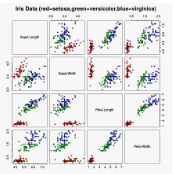Biometrics is the science of identifying an individual based on their intrinsic anatomical or behavioural characteristics, such as fingerprints, face, iris, gait, and voice. Iris recognition is one of the most successful methods because it exploits the rich texture of the human iris, which is unique even for twins and does not degrade with age. Modern approaches to iris recognition utilize deep learning to segment the valid portion of the iris from the rest of the eye, so it can then be encoded, stored and compared. This paper aims to improve the accuracy of iris semantic segmentation systems by introducing a novel data augmentation technique. Our method can transform an iris image with a certain dilation level into any desired dilation level, thus augmenting the variability and number of training examples from a small dataset. The proposed method is fast and does not require training. The results indicate that our data augmentation method can improve segmentation accuracy up to 15% for images with high pupil dilation, which creates a more reliable iris recognition pipeline, even under extreme dilation.
翻译:生物量度是根据其内在解剖或行为特征(如指纹、脸、面部、壁画、步态和声音)来识别一个人的科学。 Iris 识别是最成功的方法之一,因为它利用了人类虹膜的丰富纹理,这甚至对双胞胎来说都是独特的,不会随着年龄的下降而退化。 光线识别的现代方法利用深度学习将虹膜的有效部分与眼睛的其余部分分割开来,这样就可以对它进行编码、储存和比较。 本文的目的是通过引入新颖的数据增强技术来提高iris 语义分解系统的准确性。 我们的方法可以将具有某种伸缩水平的虹膜图像转换为任何理想的变相水平,从而增加小型数据集中培训实例的可变性和数量。 拟议的方法是快速的,不需要培训。 研究结果表明,我们的数据增强方法可以将高学生分解度图像的分解精确度提高到15%,从而产生更可靠的虹膜识别管道,即使处于极端的变异化状态下。





